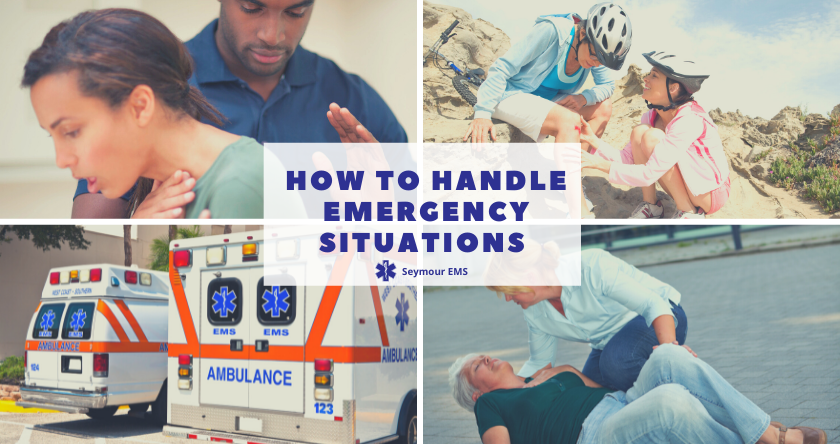Emergencies can happen anywhere and at any time. A person grabs their chest in pain, someone choking at the dinner table, or someone passing out at a ball game are all common emergency situations. But, do you know how to handle these common emergencies? And, if you were around when they happened, would you know how to react? Do you know the proper first aid techniques to help in a situation like this?
It is important to understand that people tend to hesitate to get involved when an emergency strikes. And, it isn’t that they lack compassion, it’s because they simply don’t know what to do. In the grocery store, the street, school, or at home, you may be in a situation where you are the only one available to help. So, what are the basic things you should know on how to handle emergency situations?
Call 9-1-1.
It is better to be safe than sorry and this is particularly true with an emergency. Paramedics and EMTs expect to be called to false alarms at times. It is part of their job. There will never be any hard feelings if they get to a call and realize it is not the emergency you thought it was. It is better to show up and find someone in good health than to get on the scene when it is too late.
Stay Calm.
If you can’t stay calm during an emergency, you may make things more complicated. You can actually create another injury or accident. If you can’t help safely, this is where it would be advised to not get involved at all.
Start CPR.
If you are involved with an emergency where someone is unresponsive, has no pulse, and is not breathing, you will need to start CPR until the EMS providers arrive. Explain to the 9-1-1 dispatcher that you are not familiar with what to do, and they will walk you through the steps to take over the phone. At least administering chest compressions is better than doing nothing at all.
Common Emergencies
Since some emergencies occur frequently and are known to be common, having basic facts on how to handle them can be a great help when emergency situations arise.
Dizziness and Fainting-
If someone comes up to you and tells you they feel weak, ill or dizzy, call 9-1-1 immediately, even if they refuse. Dizziness can be a sign of several different problems including:
- Heart condition
- Diabetes
- Low blood sugar
- Pregnancy
- Heart attack
- Dehydration
- Heat related problems
After calling 9-1-1 get the person to a safe and comfortable place. If you are outside, for example, find a shaded area out of the sun. Check for their alertness by having a continuous conversation with them. Ask them things to find out their level of orientation. If they are hot, cool them down with liquids and fluids. If they become unresponsive, check for a pulse and breathing. If you find they aren’t breathing, begin CPR.
Chest Pain-
Chest pain is considered a heart attack in the medical field until it is proven different. Call 9-1-1 right away if someone complains of chest pain. Check for the ABCs of EMS. Is their airway clear, are they breathing, and how is their circulation? If they are not breathing and do not have a pulse, begin to administer CPR. If you do not have experience in CPR, and don’t have access to a phone, position their head with their chin up, be sure their tongue is out of the way so their airway is open, and being chest compression.
Choking-
Choking is a common emergency, especially where eating is involved. If a person is making sound, like coughing, this is a good sign. Any sounds mean that they are breathing. It is when there is no noise at all that this becomes an emergency. It is important to know that if you perform the Heimlich Maneuver on someone who is coughing, it could make them worse. For more information on the Heimlich Maneuver and how to handle an emergency choking situations, click here.
Bleeding
– We have all heard someone say, “I’m bleeding to death.” The truth is that because we have 9 units of blood in our body, bleeding to death does not usually occur when someone is standing up pronouncing that they are injured. The scalp, fingers, toes, and nose tend to bleed the most. The rule of thumb with bleed is, if it scares you, call 9-1-1. It is no longer advised to use a tourniquet to treat bleeding as it can damage the tissue around the injury. Instead, apply direct pressure until help comes.
Seizure-
If someone is having a seizure, they can display symptoms in several ways. Falling down, erratic movements, head jerking, and eyes fluttering are some ways to tell if someone is having a seizure. Seizures can be attributed to several different sicknesses such as: high fever in children, epilepsy, or stroke. Whenever someone displays symptoms of a seizure, it is important to call 9-1-1 immediately. Don’t do anything to restrain the person, or insert anything in their mouth. Instead, remove everyone from around them and be sure there is nothing that can injure them in close vicinity. If possible, turn the person on their side. Most importantly, watch the clock. Being able to tell the Paramedics how long the seizure lasted is important.
Knowing the basics of how to handle an emergency is important for everyone. We never know when an emergency can arise. And, since they can happen anywhere and at any time, we may be the only one available to help.


Recent Comments